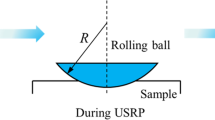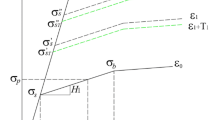Abstract
Micro-texturing on machined surface has been widely applied to improve surface friction and wear properties. This paper aimed at establishing a relationship among process parameters, machined surface texturing, and friction property of scaly surface fabricated by rotary ultrasonic rolling. Firstly, a kinematic model of the scaly surface topography formation was proposed based on motion analysis between the roller and workpiece. Secondly, the roller profile was considered in the proposed model to describe the scaly surface topography formation. Three-dimensional surface roughness characteristic parameters Sa, Sz, and Sq were adopted to evaluate the scaly surface topography. These three-dimensional surface roughness parameters can be theoretically predicted with the proposed kinematic model for the scaly surface fabricated by rotary ultrasonic rolling of titanium alloy Ti-6Al-4V. The theoretical predictions of Sa, Sz, and Sq were verified with the experimental results. Finally, the friction coefficients of scaly surfaces generated with various rotary ultrasonic rolling parameters were tested. The friction coefficient of the scaly surface was minimum at ultrasonic amplitude of 7 μm. The results demonstrated that the surface texturing with larger scaly ridges possessed improved frictional performance under identical test conditions.















Similar content being viewed by others
References
Shamanian M, Mostaan H, Safari M, Dezfooli MS (2017) Friction-stir processing of al-12%si alloys: grain refinement, numerical simulation, microstructure evolution, dry sliding wear performance and hardness measurement. Metallurgical Research & Technology 114(2):213. https://doi.org/10.1051/metal/2016066
Morteza S, Hossein M, Mehdi S, Jerzy AS (2017) Friction stir modification of GTA 7075-T6 Al alloy weld joints: EBSD study and microstructural evolutions. Arch Civ and Mech Eng 17(3):574–585. https://doi.org/10.1016/j.acme.2017.01.002
Safari M, Sousa R, Joudaki J (2020) Fabrication of saddle-shaped surfaces by a laser forming process: an experimental and statistical investigation. Metals 10(883). https://doi.org/10.3390/met10070883
Safari M, Alves de Sousa R, Joudaki J (2020) Recent advances in the laser forming process: a review. Metals 10(11):1472. https://doi.org/10.3390/met10111472
Liu KS, Jiang L (2011) Bio-inspired design of multiscale structures for function integration. Nano Today 6(2):155–175. https://doi.org/10.1016/j.nantod.2011.02.002
Dean B (1929) Bhushan B (2010) Shark-skin surfaces for fluid-drag reduction in turbulent flow: a review. Philos T R Soc A 368:4775–4806. https://doi.org/10.1098/rsta.2010.0201
Tao G, Ma C, Bai L, Shen L, Zhang J (2017) Feed-direction ultrasonic vibration−assisted milling surface texture formation. Mater Manuf Process 32(2):193–198. https://doi.org/10.1080/10426914.2016.1198029
Chen W, Zheng L, Xie W, Yang K, Huo D (2019) Modelling and experimental investigation on textured surface generation in vibration-assisted micro-milling. J Mater Process Technol 266:339–350. https://doi.org/10.1016/j.jmatprotec.2018.11.011
Shen X, Zhang J (2013) Studies on friction and wear properties of surface produced by ultrasonic vibration-assisted milling. Int J Adv Manuf Technol 67:349–356. https://doi.org/10.1007/s00170-012-4488-2
Shen X, Zhang J, Xing D, Zhao Y (2012) A study of surface roughness variation in ultrasonic vibration-assisted milling. Int J Adv Manuf Technol 58:553–561. https://doi.org/10.1007/s00170-011-3399-y
Börner R, Winkler S, Junge T, Titsch C, Schubert A, Drossel WG (2018) Generation of functional surfaces by using a simulation tool for surface prediction and micro structuring of cold-working steel with ultrasonic vibration assisted face milling. J Mater Process Technol 255:749–759. https://doi.org/10.1016/j.jmatprotec.2018.01.027
Chen W, Zheng L, Huo D, Chen Y (2018) Surface texture formation by non-resonant vibration assisted micro milling. J Micromech Microeng 28(2):025006. https://doi.org/10.1088/1361-6439/aaa06f/meta
Ding H, Chen SJ, Cheng K (2011) Dynamic surface generation modeling of two-dimensional vibration-assisted micro-end-milling. Int J Adv Manuf Technol 53:1075–1079. https://doi.org/10.1007/s00170-010-2903-0
Zhu L, Ni C, Yang Z, Liu C (2019) Investigations of micro-textured surface generation mechanism and tribological properties in ultrasonic vibration-assisted milling of Ti–6Al–4V. Precis Eng 57:229–243. https://doi.org/10.1016/j.precisioneng.2019.04.010
Sajjady SA, Abadi HNH, Amini S, Nosouhi R (2016) Analytical and experimental study of topography of surface texture in ultrasonic vibration assisted turning. Mater Design 93:311–323. https://doi.org/10.1016/j.matdes.2015.12.119
Liu X, Wu D, Zhang J, Hu X, Cui P (2019) Analysis of surface texturing in radial ultrasonic vibration-assisted turning. J Mater Process Technol 267:186–195. https://doi.org/10.1016/j.jmatprotec.2018.12.021
Zhang C, Shi G, Ehmann KF (2017) Investigation of hybrid micro-texture fabrication in elliptical vibration assisted cutting. Int J Mach Tool Manu 120:72–84. https://doi.org/10.1016/j.ijmachtools.2017.04.009
Amini S, Hosseinabadi HN, Sajjady SA (2016) Experimental study on effect of micro textured surfaces generated by ultrasonic vibration assisted face turning on friction and wear performance. Appl Surf Sci 390:633–648. https://doi.org/10.1016/j.apsusc.2016.07.064
Tong H, Li Y, Wang Y (2008) Experimental research on vibration assisted EDM of micro-structures with non-circular cross-section. J Mater Process Technol 208(1):289–298. https://doi.org/10.1016/j.jmatprotec.2007.12.126
Kim JM, Kim YK (2004) The enhancement of homogeneity in the textured structure of silicon crystal by using ultrasonic wave in the caustic etching process. Sol Energ Mat Sol C 81(2):239–247. https://doi.org/10.1016/j.solmat.2003.11.019
Teimouri R, Amini S, Bami AB (2018) Evaluation of optimized surface properties and residual stress in ultrasonic assisted ball rolling of AA6061-T6. Measurement 116:129–139. https://doi.org/10.1016/j.measurement.2017.11.001
Jerez-Mesa R, Travieso-Rodriguez JA, Gomez-Gras G, Liuma-Fuentes J (2018) Development, characterization and test of an ultrasonic vibration-assisted ball rolling tool. J Mater Process Technol 257:203–212. https://doi.org/10.1016/j.jmatprotec.2018.02.036
Zhao J, Liu Z (2016) Investigations of ultrasonic frequency effects on surface deformation in rotary ultrasonic roller burnishing Ti-6Al-4V. Mater Design 107:238–249. https://doi.org/10.1016/j.matdes.2016.06.024
Tadao T, Tohru K (1986) Evaluation of two- and three-dimensional surface roughness profiles and their confidence. Wear 109(1–4):69–78. https://doi.org/10.1016/0043-1648(86)90252-8
Klimczak T (1992) Origins, magnitude and statistical significance of differences between roughness parameters of two- and three-dimensional characteristics. Wear 156(1):19–31. https://doi.org/10.1016/0043-1648(92)90141-T
Wei S, Zhao H, Jing J (2015) Investigation on three-dimensional surface roughness evaluation of engineering ceramic for rotary ultrasonic grinding machining. Appl Surf Sci 357:139–146. https://doi.org/10.1016/j.apsusc.2015.08.230
ISO 25178-2 (2012) Geometrical product specification (GPS)-surface texture: areal – part 2: terms, definitions and surface texture parameters. International Organization for Standardization, Geneva
Yao Z, Mei D, Chen Z (2016) Modeling of metallic surface topography modification by high-frequency vibration. J Sound Vib 363:258–271. https://doi.org/10.1016/j.jsv.2015.10.037
Zhao J, Liu Z (2020) Plastic flow behavior for machined surface material Ti-6Al-4V with rotary ultrasonic burnishing. J Mater Res Technol 9(2):2387–2401 http://creativecommons.org/licenses/by-nc-nd/4.0/
Kuznetsov VP, Smolin IY, Dmitriev AI, Konovalov DA, Makarov AV, Kiryakov AE, Yurovskikh AS (2013) Finite element simulation of nanostructuring burnishing. Phys Mesomech 16:67–72. https://doi.org/10.1134/S1029959913010074
Gomez–Gras G, Travieso–Rodriguez JA, Jerez–Mesa R, Lluma–Fuentes J, de Gomis la Calle B (2016) Experimental study of lateral pass width in conventional and vibrations-assisted ball burnishing. Int J Adv Manuf Technol 87:363–371. https://doi.org/10.1007/s00170-016-8490-y
Fartashvand V, Abdullah A, Vanini SAS (2017) Investigation of Ti-6Al-4V alloy acoustic softening. Ultrason Sonochem 38:744–749. https://doi.org/10.1016/j.ultsonch.2016.07.007
Galda L, Koszela W, Pawlus P (2007) Surface geometry of slide bearings after percussive burnishing. Tribol Int 40:1516–1525. https://doi.org/10.1016/j.triboint.2007.01.010
Arenas MA, Ahuir-Torres JI, García I, Carvajal H, de Damborenea J (2018) Tribological behaviour of laser textured Ti6Al4V alloy coated with MoS2 and graphene. Tribol Int 128:240–247. https://doi.org/10.1016/j.triboint.2018.07.031
Availability of data and material
The data and material in this paper are available from the corresponding author on reasonable request.
Funding
This work was supported by the National Natural Science Foundation of China (No. 91860207). This work was also supported by grants from the Taishan Scholar Foundation and Shandong Provincial Natural Science Foundation of China (Nos. ZR2019MEE073 and 2019JMRH0307).
Author information
Authors and Affiliations
Contributions
Zhanqiang Liu and Jian Zhao conceived of the presented idea; Jian Zhao developed the theory and performed the computations; Jian Zhao and Bing Wang discussed the results and commented on the manuscript; all authors provided feedback and helped shape the research, analysis, and manuscript.
Corresponding author
Ethics declarations
Ethical approval
It is approved that the paper is original and has been written based on the authors’ own finding. All the figures and tables are original, and every expression from other published works was acknowledged and referenced.
Consent to participate
All authors are aware and satisfied with the authorship order and correspondence of the paper.
Consent to publish
All authors are satisfied that the last revised version of the paper is published without any change.
Competing interests
The authors declare no competing interests.
Additional information
Publisher’s note
Springer Nature remains neutral with regard to jurisdictional claims in published maps and institutional affiliations.
Rights and permissions
About this article
Cite this article
Zhao, J., Liu, Z. & Wang, B. Surface texture and friction property of Ti-6Al-4V processed by rotary ultrasonic rolling. Int J Adv Manuf Technol 115, 463–474 (2021). https://doi.org/10.1007/s00170-021-07197-x
Received:
Accepted:
Published:
Issue Date:
DOI: https://doi.org/10.1007/s00170-021-07197-x




